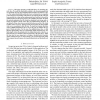Free Online Productivity Tools
i2Speak
i2Symbol
i2OCR
iTex2Img
iWeb2Print
iWeb2Shot
i2Type
iPdf2Split
iPdf2Merge
i2Bopomofo
i2Arabic
i2Style
i2Image
i2PDF
iLatex2Rtf
Sci2ools
113
Voted
INFOCOM
2000
IEEE
2000
IEEE
Optimal Streaming of Layered Video
Abstract—This paper presents a model and theory for streaming layered video. We model the bandwidth available to the streaming application as a stochastic process whose statistical characteristics are unknown a priori. The random bandwidth models short term variations due to congestion control (such as TCP-friendly conformance). We suppose that the video has been encoded into a base and an enhancement layer, and that to decode the enhancement layer the base layer has to be available to the client. We make the natural assumption that the client has abundant local storage and attempts to prefetch as much of the video as possible during playback. At any instant of time, starvation or partial starvation can occur at the client in either of the two layers. During periods of starvation, the client applies video error concealment to hide the loss. We study the dynamic allocation of the available bandwidth to the two layers in order to minimize the impact of client starvation. For the case o...
Related Content
| Added | 31 Jul 2010 |
| Updated | 31 Jul 2010 |
| Type | Conference |
| Year | 2000 |
| Where | INFOCOM |
| Authors | Despina Saparilla, Keith W. Ross |
Comments (0)

